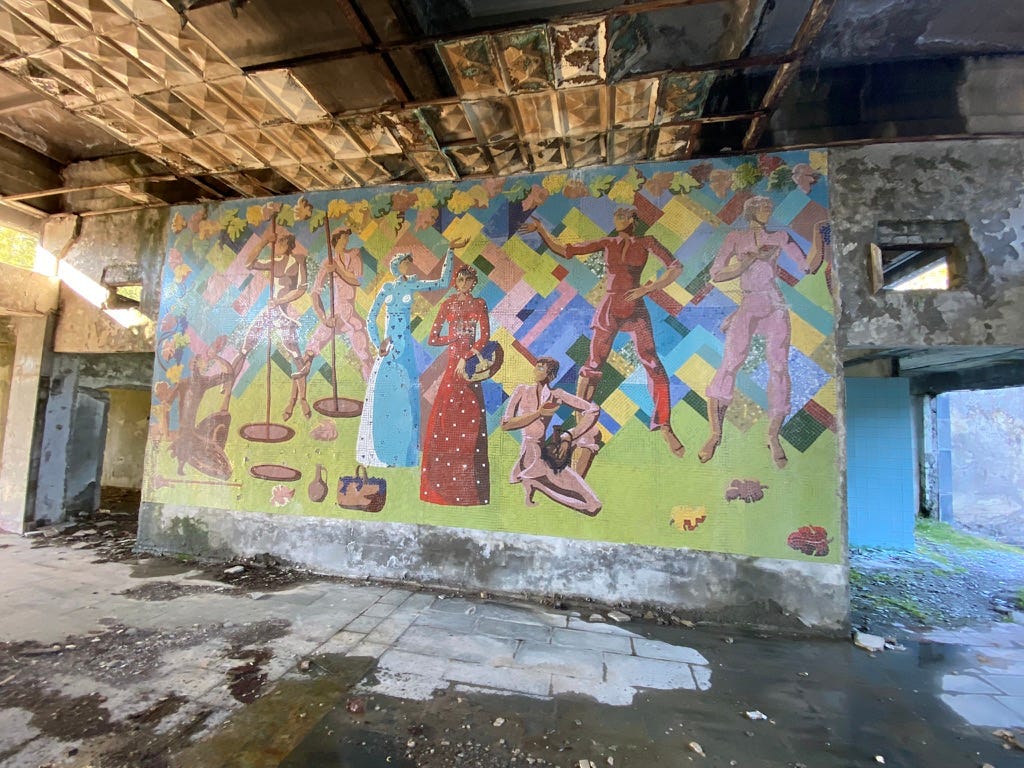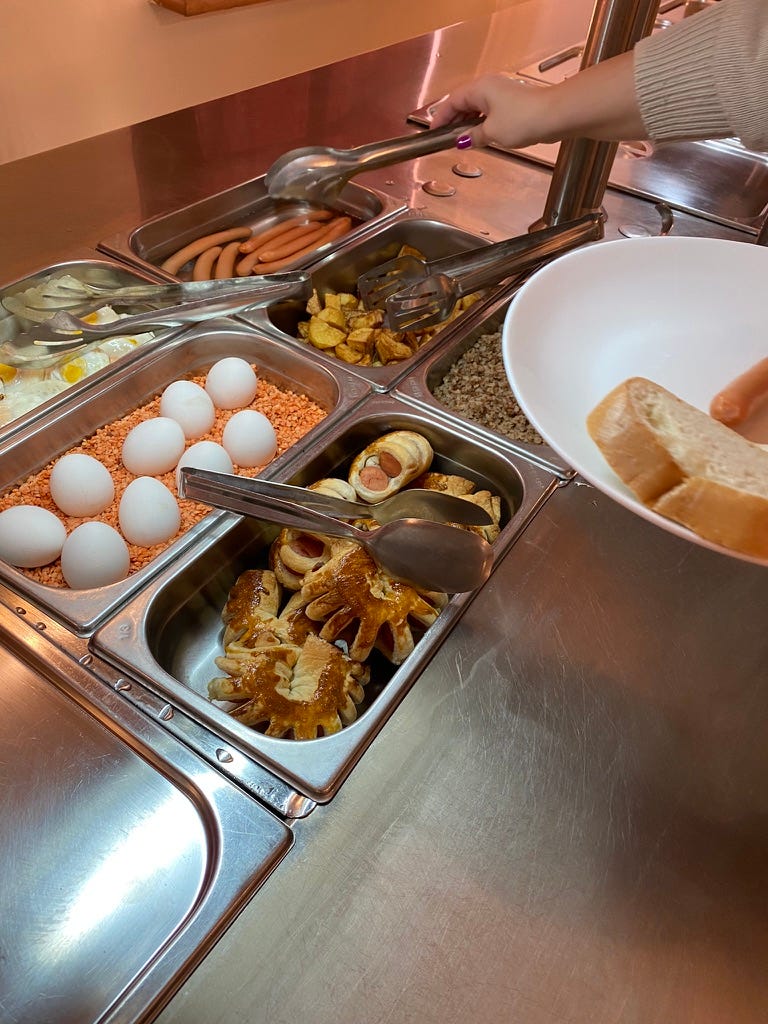Thirty years on, it’s getting increasingly difficult to find visual evidence of the Soviets.1 Bazaars have been picked over of all but the most obvious tourist fakes. Beautiful mosaics in public spaces have been removed or plastered over.
But it’s still there if you know what to look for. The Soviets, it turns out, left a lot behind.
Back in the late 90s and early 2000s, the “Euro-Remont” was an important signifier for apartment hunters in Kyiv, Moscow, Baku and Tbilisi. When looking for a place to live, you’d know that in an Euro-Remont apartment, the most egregious design choices of the late Soviet era would have been thoughtfully replaced by different, but equally egregious, design choices.
These choices usually reflected the owner’s interpretation of a European living space. That vision was a product of many influences; few, if any, were recognizably European.
The defining characteristic of any Remont, as longtime Carpetblog readers know, is that it is, at its core, superficial. The space always retains its fundamental Soviet-ness.
The deep decay can only truly be removed by digging down to the substrate, removing the rot and starting over fresh. That didn’t happen very often. It was all covered up, mostly. This is an instructive model for thinking about a lot of things the Soviets left behind.
Here we are, a few decades later. The Euro-remont is dated and the paint is bubbling. The mold, covered by fuzzy wallpaper, has started to show through. But what did it look like before the cheap workmanship and mass-produced polyester carpet was covered by wood floors made of plastic?
I know now! I recently spent a weekend in Tskaltubo, in western Georgia, near Kutaisi. The whole point of visiting this small town is to see Soviet-era design without the filter of the Euro-remont.
From the 50’s through literally August 1991, comrades from all over the USSR visited Tskaltubo to take the waters2 at dozens of sanatoria situated around a beautiful park. It was peak Soviet: state subsidized rest for everyone, as mandated in the constitution. Workers came from all over the country for arcane treatments that took advantage of the town’s hot springs. Metalworkers had their own sanatorium; so did railway workers, among others. It’s not hard to imagine how much solidarity you could get up to in 1976, in between treatments, with your closest metallurgist comrades in pools filled with radon. The photos in this article are much better than mine (substack is harder to put photos in than 2005-era Blogspot).
Now, almost all of the sanatoria are in a state of absolute ruin. Rumors swirl that this one or that one has been bought by an international brand (probably true) or a Cairene (unverified) or Georgia’s former PM and Russian oligarch Bidzina Ivanishvili (¯\_(ツ)_/¯), all of whom are eager target the demographic that thinks sitting in radioactive water is healthy3. Those rumors have been around for a decade at least.
For now though, Tskaltubo is a destination for urban explorers who climb around to look for old mosaics4 and other relics of the resort’s history. Because many santoria became housing for Internally Displaced Persons (IDPs) from the 1992 war in Abkhazia, people have been living in them for 30 years, in generally poor conditions. It’s all rather grim. I didn’t really enjoy that part.
A wing of the Tskaltubo Spa Resort, one of the largest (more than 800 rooms!) has been converted into a pretty standard hotel (some say it’s four star – more like a three star with an addition error). It represents the platonic ideal of a Euro-Remont. It looks very nice (and for the most part it is pretty decent), but you won’t break a fingernail scratching the surface to see what it was like in its heyday— the neoclassical Stalinist architecture, the floor plans, arched windows with metal latches, chandeliers, all remain. There is a theater, with a stage and a piano. It all looks very functional for events or meetings for which Kutaisi is too fancy.
My policy in situations like this is “if there’s an unlocked door, go through it or a curtain look behind it.” Jackpot.
In the balcony of the theater the resort, behind the rows of unrestored 80’s style loge seats, my friends — a Georgian and Ukrainian who are too young to remember the Cold War yet kindly indulge my whims — and I found red and gold banners from 1991, urging comrades to support Perestroika for the glory of October and Lenin. I picked up an old newspaper from mid-August 1991.

Clearly this theater had been in use up until the minute the whole operation collapsed. It played its best, final role, trying to hold back the coming tsunami, using the only tools available to it: clumsy propaganda aimed at captive audiences. No one bothered to take it away. It’s all just sitting there.
Another balcony door opened into the theater’s projection room, mostly untouched for 30 years, based on the newspapers lying around. Three clunky Samsung projectors still held the evening’s film, with the next spool in a canister ready for loading. Cobra-era Sylvester Stallone looked on with approval.

We ran downstairs to the stage. My friends played staples of a 90’s post-Soviet childhood – the theme from Umbrellas of Cherbourg and the Theme from Titanic – to the empty theater, while I explored other backstage rooms, filled with broken furniture, ancient theater lights and uncomfortable odors.
Tempted by rumors of “Stalin’s Room,” at the hotel we persuaded the staff to show it to us. Was it really Stalin’s room? Maybe, maybe not. But the wing housing it was absolutely untouched for more than 30 years. No IDPs had been living in it. No Euro-Remont for the benefit of hotel guests. Just shredded yellow polyester curtains shivering in the spring breeze coming through the broken windows, toothpaste- colored paint (Soviet color palette: Toothpaste green) that gave my companions hives and rotten herringbone parquet floors. One room held jars of alchemic powders, beakers and broken health devices, the handwritten Russian on which was untranslatable. Another was full of old carpets (maybe one was Stalin’s? Intriguing). Another held dusty billiards tables behind a locked door.

A man in his 60s had stopped planting flowers in the expansive garden to let us in. “Tell us, please, why is this sanatorium such a perfect time capsule when all the rest are in advanced decay?”
In its previous life, the Tskaltubo Spa Hotel was the sanatorium for the Soviet Ministry of Defense, he told us. He had worked for it. He explained that when IDPs began streaming into Tskaltubo in 1992, looking a place to live, he and his colleagues stood armed at the gate, preventing them from taking up residence in its 800 rooms. The Ministry of Defense’s sanatorium protected by an armed militia in 1992 was probably sufficiently intimidating, even for people who had no where else to go.
The result: the shell of a rotten regime that no one bothered to paint over with garish colors and harsh lights for the benefit of uncritical audiences who wanted something that looked nice, even if the foundation was crumbling. It’s still there, exposed to the elements and decaying. Let it go.
There’s plenty of non-visual evidence the Soviets and their heirs. You can watch the news for that
Imagine the wellness practices of your goofiest woo-friends if they were Soviets and it was 40 years ago and you’ll get an idea of the kinds of treatments people got there. There’s probably another post that can be written about such parallels.
They’ve done the research on that. It’s all very promising
The few remaining seem to have been designed by the Mozaik Collective’s interns. They’re not very impressive.








Great article as well
Right??? The "now what is this good for?" question doesn't get answered with a lot of clarity. The medicine room was crazy. Dozens of bottles of powders. My Ukrainian friend had no idea what the labels meant. Did not sample.